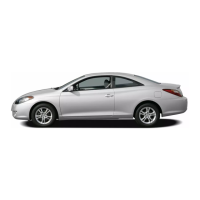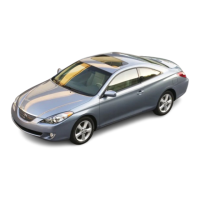Do you have a question about the Toyota Solara 2002 and is the answer not in the manual?
Provides an overview of the car's instruments and controls, detailing their locations and functions.
Details the operation and security of vehicle keys and doors, including locking and unlocking mechanisms.
Covers the adjustment and usage of seats, seat belts, steering wheel, and mirrors for safety and comfort.
Explains the operation of headlights, turn signals, wipers, washers, and defogger systems.
Explains the operation of the ignition switch, transmission selector, and parking brake.
Details recommended fuel types, octane ratings, and tank capacity for the vehicle.
Details the dual-circuit hydraulic brake system, brake booster, and anti-lock brake system (ABS).
Guides users through troubleshooting steps and procedures when the vehicle fails to start.
Provides instructions on what to do if the engine stalls while the vehicle is in motion.
Explains how to handle engine overheating, including checks for coolant leaks and fan operation.
Provides a step-by-step guide for changing a flat tire, including safety precautions and tool usage.
Details the recommended methods and precautions for towing the vehicle, including different truck types.
Outlines the importance of regular maintenance for vehicle performance, safety, and warranty compliance.
Offers critical safety precautions and warnings for owners performing maintenance on their vehicle.
Covers essential checks and maintenance for the engine and chassis components.
Provides instructions and precautions for checking and topping up the engine oil level.
Details how to check engine coolant levels, recommended coolant types, and leak detection.
Explains how to check brake fluid levels and the importance of using the correct fluid type.
Emphasizes the importance of proper tire pressure and provides instructions on how to check it accurately.
Covers how to check tires for wear indicators and damage, and guidelines for tire replacement.
Covers checks and maintenance for key electrical components like the battery, fuses, and bulbs.
Explains how to check battery condition, including exterior inspection and terminal maintenance.
Provides essential safety precautions and procedures for recharging the vehicle battery.
Guides users on how to check and replace blown fuses, including the use of a pull-out tool and spare fuses.
Provides an overview of the car's instruments and controls, detailing their locations and functions.
Details the operation and security of vehicle keys and doors, including locking and unlocking mechanisms.
Covers the adjustment and usage of seats, seat belts, steering wheel, and mirrors for safety and comfort.
Explains the operation of headlights, turn signals, wipers, washers, and defogger systems.
Explains the operation of the ignition switch, transmission selector, and parking brake.
Details recommended fuel types, octane ratings, and tank capacity for the vehicle.
Details the dual-circuit hydraulic brake system, brake booster, and anti-lock brake system (ABS).
Guides users through troubleshooting steps and procedures when the vehicle fails to start.
Provides instructions on what to do if the engine stalls while the vehicle is in motion.
Explains how to handle engine overheating, including checks for coolant leaks and fan operation.
Provides a step-by-step guide for changing a flat tire, including safety precautions and tool usage.
Details the recommended methods and precautions for towing the vehicle, including different truck types.
Outlines the importance of regular maintenance for vehicle performance, safety, and warranty compliance.
Offers critical safety precautions and warnings for owners performing maintenance on their vehicle.
Covers essential checks and maintenance for the engine and chassis components.
Provides instructions and precautions for checking and topping up the engine oil level.
Details how to check engine coolant levels, recommended coolant types, and leak detection.
Explains how to check brake fluid levels and the importance of using the correct fluid type.
Emphasizes the importance of proper tire pressure and provides instructions on how to check it accurately.
Covers how to check tires for wear indicators and damage, and guidelines for tire replacement.
Covers checks and maintenance for key electrical components like the battery, fuses, and bulbs.
Explains how to check battery condition, including exterior inspection and terminal maintenance.
Provides essential safety precautions and procedures for recharging the vehicle battery.
Guides users on how to check and replace blown fuses, including the use of a pull-out tool and spare fuses.
| Brand | Toyota |
|---|---|
| Model | Solara 2002 |
| Category | Automobile |
| Language | English |












